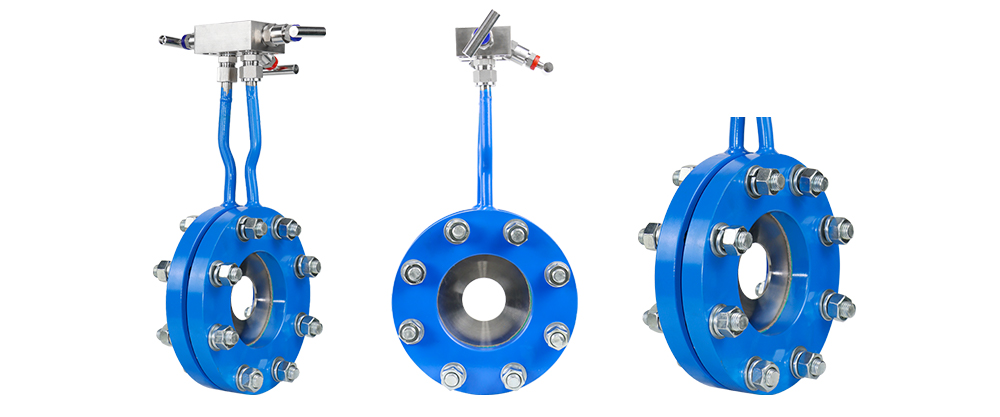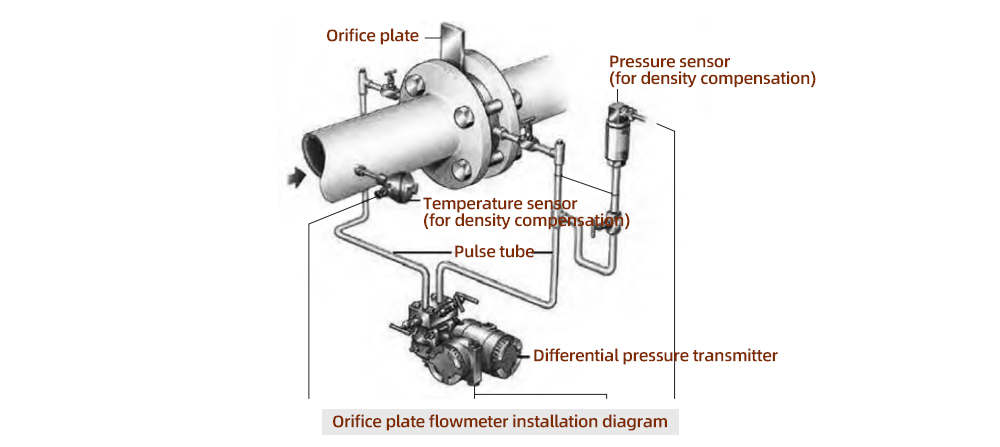The demand for oil, gas and water flow measurement is very common in the production process of oil and gas fields. Whether the flowmeter selection is reasonable will directly affect the measurement accuracy of process medium and the later operation and maintenance cost. This paper briefly introduces the classification, characteristics and measurement principle of oil, gas and water flow meters commonly used in oil and gas fields. It discusses the application scope and selection principle of various flow meters.
Introduction to commonly used flow meters:
Flowmeter is an important detection instrument in oil and gas fields, and plays an important role in oil and gas field flow stations. Flow meters are an essential tool for energy management and custody transfer, and are also widely used in oil field water injection, sewage treatment, etc. The flowmeters used in China are mainly divided into low-pressure flowmeters, differential pressure flowmeters, float flowmeters, booster flowmeters, velocity flowmeters, electromagnetic flowmeters, mass flowmeters, etc. According to their structural principles. Different types of flow meters have their own characteristics. Therefore, in practical applications, it is necessary to select the most appropriate flow meter according to different measurement purposes to achieve the best measurement results.
Commonly used oil, gas and water flow meter classifications:
Crude
Coriolis mass flowmeter, scraper flowmeter, double rotor flowmeter, oval gear flowmeter, target flowmeter, turbine flowmeter, vortex flowmeter, etc.
Natural gas
Ultrasonic flowmeter, precession vortex flowmeter, gas turbine flowmeter, vortex flowmeter, orifice flowmeter, etc.
Oilfield wastewater
Electromagnetic flowmeter, flow controller, electronic water meter, float flowmeter, etc.
Characteristics of flow meters commonly used in oil and gas fields:
Differential pressure flow meter
Differential pressure flowmeter is the most widely used type of flowmeter, among which the throttling differential pressure flowmeter in which the detection parts are standard parts is the most popular. A throttling differential pressure flowmeter consists of a throttling device, a differential pressure transmitter and a flow display instrument. Commonly used throttling parts include orifice plates, venturi tubes, nozzles, etc.
Orifice flow meters are widely used in oil and gas fields.
Advantages of orifice flowmeter:
(1) The standard throttling parts are universally used around the world and recognized by international standards organizations. They can be put into use without real flow calibration and are unique among flow meters.
(2) The structure is easy to copy, simple, strong, stable and reliable in performance, and low in price.
(3) It has a wide range of applications, including all single-phase fluids (liquid, gas, steam) and some mixed-phase flows. Products are available for pipe diameters and working conditions (temperature, pressure) in general production processes.

Disadvantages of orifice flowmeter:
(1) The repeatability and accuracy of measurement are at a medium level among flow meters. Due to the complex influence of many factors, it is difficult to improve the accuracy.
(2) The range is narrow. Since the flow coefficient is related to Reynolds number, the general range is only 3:1~4:1.
(3) There are long straight pipe length requirements, which are generally difficult to meet, especially for larger pipe diameters, the problem is more prominent.
(4) Large pressure loss and high energy consumption.
(5) The orifice plate uses sharp angles in the inner hole to ensure accuracy, so it is sensitive to corrosion, wear, scaling, and dirt. The accuracy of long-term use is difficult to guarantee, and it needs to be dismantled and inspected once a year.
(6) The flange connection is easy to cause running, popping, dripping and leaking problems, which greatly increases the maintenance workload.
Installation of orifice flow meter:

Float flow meter
The float flowmeter, also known as the rotor flowmeter, is a type of variable area flowmeter. In a vertical tapered tube that expands from bottom to top, the gravity of the float with a circular cross-section is borne by the liquid power, so that the float can Rise and fall freely within the conical tube. The float flowmeter plays a decisive role in small and micro flow.
Main features of rotameter:
(1) The glass cone tube float flowmeter has a simple structure and is easy to use. The disadvantage is that it has low pressure resistance and has a greater risk of the glass tube being fragile.
(2) Suitable for small pipe diameters and low flow rates.
(3) The pressure loss is low.
Volumetric flow meter
Positive displacement flowmeter, also known as fixed displacement flowmeter, uses mechanical measuring elements to continuously divide the fluid into a single known volume part, and measures the total volume of the fluid based on the number of times the measuring chamber is filled and discharged with the fluid in this volume part. . Volumetric flowmeters, differential pressure flowmeters and float flowmeters are listed as the three most commonly used flowmeters and are often used for total volume measurement of expensive media (oil products, etc.).
Volumetric flowmeters can be divided into oval gear flowmeters, scraper flowmeters, double rotor flowmeters, rotating piston flowmeters, reciprocating piston flowmeters, disc flowmeters, liquid-sealed rotary drum flowmeters, etc. according to their measuring components. Wet gas meters and membrane gas meters, etc.
Advantages of positive displacement flow meters:
(1) High measurement accuracy.
(2) The installation pipeline conditions have no impact on the measurement accuracy, and there is no need for straight pipe sections.
(3) Can be used for measurement of high viscosity liquids.
(4) Wide range.
(5) The direct-reading instrument can directly obtain the cumulative total without external energy, which is clear and easy to operate.
Disadvantages of positive displacement flow meters:
(1) The structure is complex and the volume is huge.
(2) There are great limitations in the type, caliber, and working state of the medium being measured.
(3) Not suitable for high and low temperature situations.
(4) Most instruments are only suitable for clean single-phase fluids.
(5) Produce noise and vibration.
Turbine flow meters use a multi-blade rotor (turbine) to sense the average flow velocity of the fluid and thereby derive the flow rate or total volume. Generally, it consists of two parts: sensor and display, and can also be made into an integral type.
Turbine flowmeters, volumetric flowmeters, and Coriolis mass flowmeters are called the three types of flowmeters with the best repeatability and accuracy.
Advantages of turbine flow meters:
(1) High precision.
(2) Good repeatability.
(3) No zero point drift and good anti-interference ability.
(4) Wide range.
(5) Compact structure.
Disadvantages of turbine flowmeter:
(1) Calibration characteristics cannot be maintained for a long time.
(2) Fluid physical properties have a great influence on flow characteristics.
Turbine flow meters are widely used in the following measurement objects:
Petroleum, organic liquids, inorganic liquids, liquefied gas, natural gas and cryogenic fluids, etc. The application of turbine flowmeter in natural gas measurement is second only to orifice flowmeter.
Electromagnetic flowmeter (EMF)
The SS316 electromagnetic flowmeter is an instrument that measures the flow of conductive liquid media based on Faraday’s law of electromagnetic induction. SS316 Electromagnetic flowmeter has a series of excellent characteristics and can measure dirty flow and corrosive flow.
Advantages of electromagnetic flowmeter:
(1) The measurement channel is a smooth straight tube that will not be blocked and is suitable for measuring liquid-solid two-phase fluids containing solid particles, such as pulp, mud, sewage, etc.
(2) There is no pressure loss caused by flow detection, and the energy saving effect is good.
(3) The measured volume flow rate is actually not significantly affected by changes in fluid density, viscosity, temperature, pressure and conductivity.
(4) Large flow range and wide caliber range.
(5) Corrosive fluids can be used.
Disadvantages of electromagnetic flowmeter:
(1) It has certain limitations. It can only measure the liquid flow of conductive media and cannot measure the flow of non-conductive media.
(2) The installation and debugging are more complicated than other flow meters, and the requirements are more stringent. There should be no vibration or strong magnetic field in the installation location. During installation, the transmitter and pipeline must have good contact and good grounding. The gas remaining in the measuring tube must be exhausted during use, otherwise it will cause large measurement errors.
(3) When used to measure viscous liquids with dirt, sticky matter or sediment adheres to the inner wall of the measuring tube or the electrode. If the dirt on the electrode reaches a certain thickness, the meter may not be able to measure.
Electromagnetic flowmeters are widely used in oil and gas field water injection, sewage treatment, papermaking, municipal water supply and drainage and other fields.
There are two types of mass flow meter: direct type and indirect type. Direct mass flowmeters use principles directly related to mass flow to measure. Currently, there are only two types of mass flowmeters, thermal mass flowmeters and Coriolis force mass flowmeters, that have become commercially available. Indirect mass flow meters are the most popular ones with pressure and temperature compensation.
Advantages of thermal mass flow meter (constant temperature difference TMF):
(1) The ball valve is easy to install and disassemble, and can be installed under pressure pack.
(2) The measured value is not affected by pressure and temperature.
(3) Respond quickly.
Shortcoming:
(1) The accuracy is not as good as other types of flow meters, generally 3%.
(2) The scope of application is narrow and can only be used to measure dry non-explosive gases, such as compressed air, nitrogen, argon and other neutral gases.
Coriolis Mass Flow Meter (CMF)
Coriolis mass flowmeter is a direct mass flowmeter that uses the principle of Coriolis force that is proportional to the mass flow when fluid flows in a vibrating tube.
Advantages of Coriolis mass flow meters:
(1) Directly measure mass flow rate with high accuracy.
(2) The measured value is not affected by physical properties (density, viscosity).
(3) There are no requirements for front and rear straight pipe sections.
(4) Can measure various non-Newtonian fluids and viscous and particle-containing fluids serum.

Disadvantages of Coriolis mass flow meter:
(1) It is heavy, bulky and expensive.
(2) The zero point is unstable.
(3) Only limited to small and medium calibers.